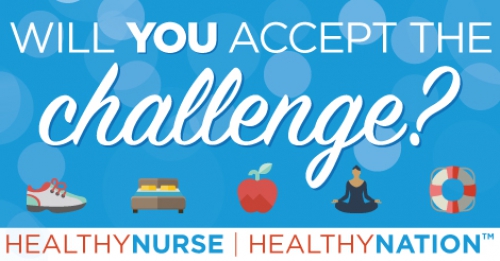Healthy Nurse, Healthy Nation™ Blog - Workouts For Everyone!
Published
 Here’s how to start exercising, no matter what’s holding you back.
Here’s how to start exercising, no matter what’s holding you back. Let’s face it, if you’re not exercising regularly, there’s probably a good reason. As nurses, we know how important it is to meet the Department of Health and Human Services’ recommended 150 minutes of moderate aerobic activity or 75 minutes of vigorous aerobic activity each week, or a combination of both. Exercise strengthens our heart and other organs, boosts energy, helps us sleep better, and is crucial to maintaining a healthy weight.
But when we already have too much on our plates, adding in exercise seems impossible. That’s why we’ve asked a health expert to weigh in: Sabrena Jo, Director of Science and Research Content for the American Council on Exercise (ACE), shares her advice for incorporating physical activity into your life, no matter what you’re going through. Here are some of the reasons nurses cite for not exercising:
“I’m suffering from chronic pain.”
Anyone experiencing pain should schedule a visit with their health care provider for a full evaluation. Your provider will also let you know if it’s safe for you to add more activity into your life. “Once your provider says it’s OK to be active, go for it! The best activity to start with is walking,” says Jo. Walking is unlikely to exacerbate pain, it’s free, and you can do it anywhere.
“Any physical movement that doesn’t trigger pain, is something you can do,” says Jo. For instance, experiment with bodyweight exercises, try the elliptical machine, or swim. Jo also suggests people suffering from pain, reframe their thoughts on exercise. “Providers actually recommend movement to help manage or reduce pain. But if a person is in pain then he or she is less likely to be motivated to do it. That’s especially true in research on people with arthritis.” Reframe your idea of exercise. Instead of thinking of it as something you have to do, think of it as a way to help manage your pain.
“I’m dealing with an injury.”
When you have an acute injury – you twisted your ankle, hurt your elbow, or pulled a muscle – it’s true that you need to rest that particular part of the body. But being active in ways that don’t involve that body part can actually help with healing. “Exercise helps heal the injury by bringing oxygen, nutrients, and blood flow to the area,” says Jo. It’s just a matter of finding ways to be active that don’t involve that particular body part. So, if you have a backache, try walking. If you hurt your lower body, lift light weights with your upper body or swim. And if the injury is to your arms, try riding a stationary bike or going for a walk.
“I don’t have enough child care.”
When you’re off the clock at the hospital, you’re likely on duty with your family and that can be tough when it comes to fitting in fitness. However, many gyms provide surprisingly affordable childcare because they understand their clients have families. Investigate the childcare options and prices at nearby gyms. Getting childcare when you otherwise wouldn’t have it may even motivate you to work out and give you some much-needed alone time.
If gym childcare isn’t an option, you might be able to trade off child-watching duties with a spouse or friend. Even getting in one hour per week of alone time to exercise is a great start.
Jo also suggests squeezing in exercise during your kids’ activities. For example, when your child is at soccer practice, walk the perimeter of the field as opposed to watching from the sidelines.
You also might want to consider finding ways to move more with your children. Is your child young enough to put in a stroller so you can jog or walk? Can you play active games like tag or Duck, Duck, Goose, so you can all get in some activity? Consider reframing some of the time you spend together so you and your kids can become healthier.
“I don’t have the time and I work odd hours.”
If you’re a nurse, you’re probably short on time and managing a crazy schedule. If you’re truly crunched for time, you don’t want to lose precious minutes commuting to a gym, looking for parking, or signing up for a class in advance. The good news: A variety of exercise programs are available any time you want right from your own fingertips (provided you have Internet access). Even better, you can find workouts that fit the amount of time you have and the equipment you have on hand (even if it’s none!). Try ACE’s Total-Body Workout for Beginners or a routine from ACE’s YouTube Channel.
“I’m exhausted.”
If you work night shifts or are just plain tired, the last thing you probably want to do is work out. Before starting an exercise program, see your health care provider to make sure you don’t have sleep apnea.
“It may seem counter-intuitive, but if you’re dealing with general tiredness, exercise can actually make you feel more alert,” Jo says. “Becoming more aerobically fit fights fatigue because it enhances your ability to take in and use oxygen. Shuttling more of that oxygen to your brain means you’ll actually feel more alert.”
Jo’s final piece of advice? “Any movement is better than none.” So anything you do – whether it’s a walking meeting, taking the stairs at work, or a speed walk during your lunch break – is a great way to squeeze in some activity.
Are there other reasons that keep you from exercising? We busted other fitness excuses in the past – check them out here. Let us know if we missed a reason and we might cover it in a future blog post. Are you inspired to incorporate more activity into your life now? Let us know in our discussion or on Facebook.
Find this helpful? Consider sharing it with a friend by clicking on the social media icons on the left side of this page. Don't forget to tag us with #HealthyNurse. Find us on Facebook, Twitter, or Instagram.

Have you joined the Healthy Nurse, Healthy Nation (HNHN) Grand Challenge yet? Join us today!
Updated 12/8/22
Blog Physical Activity
03/30/2018 7:41am CDT



Post a Comment or Question